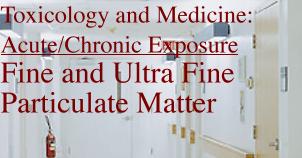 |
||||||||
 |
||||||||
Acute Exposure |
||
Chronic Exposure |
||
CALENDAR |
||||||||||||||

There is growing recognition of the importance of particle size on toxicity of particulate matter (PM), a term that collectively refers to all particulate matter regardless of size, and on the toxicity of other chemicals which, in combination with or attachment to PM, can exert a greater or more far reaching effect. Recongition of this by the U.S. Environmental Protection Agency (EPA) and the National Academy of Sciences (NAS) led to the 1997 inclusion of 2.5 um fine particulate matter (FPM; 2.5 microns, or um in diameter) as a criteria air pollutant under the Clean Air Act (CAA), for control of three month and one year averages. This was an added category to the already existing coarse particulate matter, < 10 um, a recognition of the distinct toxic and exposure characteristics of smaller particulate matter. In the past few years, the importance of ultrafine particulate matter, or 0.1 um or less (UFPM; 1/25 the size of fine particulate matter), has become known. There are at least three reasons for the interest in toxicity of increaslying small particle sizes (size matters, in reverse):
1. Smaller particles have proportionately greater surface area, per mass, than larger particles
2. Smaller particles have greater velocity and can reach into deeper regions of the pulmonary region
3. Smaller particles can better penetrate the increasingly narrow bronchioles and alveolar sacs, and can penetrate other tissues including capillaries and brain tissue
With proportionately greater surface area PM can interact more readily with cell surfaces and can adsorb more of other chemicals, which in turn interact with cell surfaces. Reaching deeper into the pulmonary region allows for more damage and damage that is more insidious since it may not be discovered for an extended period of time. Deposition rates into lung tissue for particles, based on size, greatly increase from less than 10-15 percent for coarse particles to more than sixty-six percent for ultrafine particles. The interaction of these particles and adsorbed chemicals with tissue and is thought to produce inflammation and to stimulate other types of immune and non immune pathogenic processes. The smallest particles, UFPM, have been shown to quickly penetrate into the general circulation and to penetrate into tissue including brain tissue.
(continued)
Studies have shown that inhaled radiolabled carbon UFPM were in the blood stream within one minute and reached a maximum within ten to twenty minutes, with a plateau for approximately one hour (Nemmar et al, 2002; Kreyling et al, 2004). Inhaled Magnesium oxide through the nostrils of rats collected in the olfactory bulb and disseminated into the lungs, and the striatum, the cerebellum and cerebral cortex of the brain (Elder et al, 2006). Various inflammatory factors such as macrophage inflammatory protein-2, were increased in the olfactory bulb.
These results are consistent with and support findings that PM in general and the smaller particulate matter more specifically, are associated with increased pulmonary and cardiac mortality (Delfino et al, 2005; Frampton, 2001) and with increased risk of pre term deliveries (Leem et al, 2006). Each of these factors will be covered in more depth in the coming weeks.
References:
Delfino RJ, Sioutas C, Malik S (2005) Envir. H.Persp. 113: 934-46
Elder A et al (2006) Envir.H. Persp. 114:1172-78
Frampton MW (2001) Envir. H. Persp. 109:529-32
Kreyling WG, Semmler M, Moller W (2004) J Aerosol Med. 17:140-52
LeemJH et al (2006) Envir H Persp 114:905-10.
Nemmar A, Hoet PHM, et al (2002) Circulation 105:411-4
See also:
